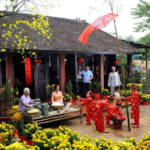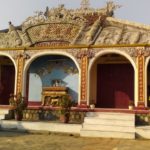Tư Hiếu Temple is a renowned ancient spiritual destination in the Imperial City of Hue. Every day, this serene and picturesque site welcomes a large number of visitors seeking tranquility and peace. If you’re looking for a quiet and idyllic place to explore and find solace, Tư Hiếu Temple is the perfect spot for you. Join us as we discover the beauty and history of Tư Hiếu Temple in today’s article!
1 Introduction to Tư Hiếu Temple in Hue
Location of Tư Hiếu Temple, Hue
Tư Hiếu Temple is nestled in Dương Xuân Thượng Village, Thủy Xuân Ward, Huế City, Thừa Thiên Huế Province. The temple is hidden amidst a vast pine forest, about 5km southwest of the city center.
The area boasts a poetically charming landscape and a particularly cool atmosphere. Each season paints the temple with a unique hue, making it a delightful destination to visit throughout the year.
 Introduction to Tư Hiếu Temple in Hue
Introduction to Tư Hiếu Temple in Hue
How to Get to Tư Hiếu Temple
- Motorcycle: This is the most popular means of transportation to reach Tư Hiếu Temple. From Hue’s city center, follow Nguyễn Lộ Trạch Street, cross the Trường Tiền Bridge, and then turn left onto Kim Long Street. Continue for about 3km until you see the signboard directing you to Tư Hiếu Temple.
- Taxi: You can take a taxi from Hue’s city center to Tư Hiếu Temple for approximately 100,000 – 150,000 VND per trip.
- Bus: Take bus number 2 or 10 from the city center to Thủy Xuân Park bus stop, and then walk about 1km to reach the temple.
 How to Get to Tư Hiếu Temple
How to Get to Tư Hiếu Temple
History of Tư Hiếu Temple
Tư Hiếu Temple was constructed in 1843 during the reign of Emperor Thiệu Trị, initially bearing the name Diên Hựu Temple. The emperor built the temple as a place of worship and meditation for his mother, Empress Từ Dụ. Following her demise, Emperor Thiệu Trị renamed the temple as Tư Hiếu to honor her memory.
Tư Hiếu Temple is not only a prominent spiritual destination but also a historic site of significant cultural value. In 1992, it was recognized as a National Historical and Cultural Relic by the Ministry of Culture, Sports, and Tourism.
 History of Tư Hiếu Temple
History of Tư Hiếu Temple
2 Exploring Tư Hiếu Temple – The Ancient Temple of the Imperial City
Admiring the Architecture of Tư Hiếu Temple
Tư Hiếu Temple showcases the distinctive traditional architecture of Vietnam, featuring curved tile roofs, moss-covered walls, and a spacious compound surrounded by lush green trees.
Notable architectural highlights of the temple include:
- Three-entrance Gate: Constructed with three layers of roofs, topped with a statue of Amitabha Buddha.
- Đại Hùng Palace: Housing wooden statues of Shakyamuni Buddha and various bodhisattvas.
- Ancestral House: Dedicated to the veneration of the temple’s past abbots.
- Phước Duyên Tower: Containing the relics of Zen Master Thích Nhất Hạnh.
 Admiring the Architecture of Tư Hiếu Temple
Admiring the Architecture of Tư Hiếu Temple
Visiting the Unique Cemetery of the Nguyễn Dynasty Eunuchs
In addition to its unique architecture, Tư Hiếu Temple also attracts visitors with its special cemetery dedicated to the eunuchs of the Nguyễn Dynasty. This cemetery, located within the temple grounds, houses over 200 graves of these royal servants.
 Visiting the Unique Cemetery of the Nguyễn Dynasty Eunuchs
Visiting the Unique Cemetery of the Nguyễn Dynasty Eunuchs
Legend has it that eunuch Châu Phước Năng greatly assisted Zen Master Nhất Định in expanding the temple. Touched by his kindness and aware of the lack of retirement homes for aged eunuchs in the royal court, Zen Master Nhất Định invited contributions from the eunuchs to expand Tư Hiếu Temple, offering them a place to spend their golden years.
 Visitors exploring and worshipping at Tư Hiếu Temple
Visitors exploring and worshipping at Tư Hiếu Temple
Tư Hiếu Temple is a spiritual attraction that captivates visitors to Hue. It exudes an air of antiquity and tranquility while preserving the cultural and historical values of Vietnam.
Explore 12 Amazing Destinations for Biking Trips
Unlock Vietnam in a brand new way with an exciting biking tour! Discover the stunning beauty of the country with Dien May XANH’s top 12 must-see destinations. From sweeping plains to clear blue beaches and mountainous vistas – experience all the sights with your own personal cycling tour. Find your ideal route and set out for an adventure today!



































